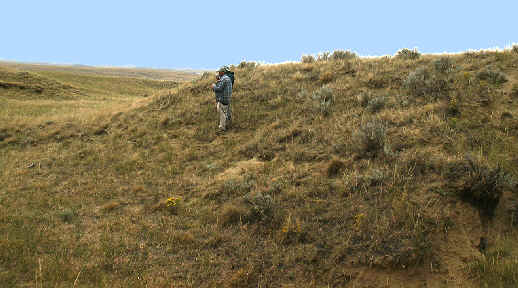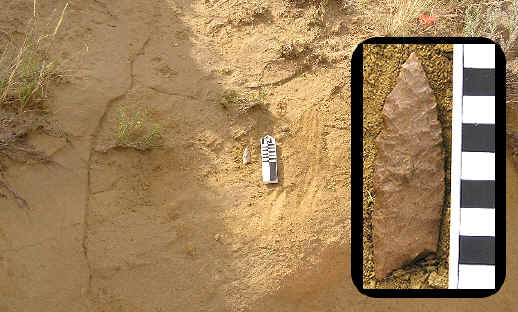|
||
|
||
|
"----bison kill sites seem to be the most frequent and obvious of the major archaeological manifestations on the high plains. In the future, a proportionately larger share of our archaeological interpretations will probably have to come from these types of sites".---1974, George C. Frison, "The Casper Site, A Hell Gap Bison Kill on the High Plains" chapter 7 Concluding Summary p. 241.
THE
DILTS SITE by Jason LaBelle The Dilts site (48CA4718) is a new Paleo-Indian locale discovered in August 2003 by archaeologists working for Western Land Services out of Sheridan, Wyoming. Like many archaeologists working in North America, our survey crew (Juanita Mines & Jason Garber) documents archaeological sites located within areas slated for, in this case, energy development. Important sites are literally being discovered and preserved on a daily basis through this work. The Dilts site was discovered in advance of the drilling of coal bed methane gas wells in Campbell County, Wyoming which represents one of the fastest growing industries in the Powder River Basin of northern Wyoming. |
||
|
||
|
The single point was found by Juanita Mines where it lay on the bank of a dry wash, in association with fragments of bison bone. No other tools have been found on the site so far. Most of the bone was highly fragmented, probably from natural agents such as decay and erosion. We simply don't know, with the evidence at hand, if humans stripped meat off these bones or smashed them for the bone grease and marrow. The bones look to be from a single buffalo, and includes parts of the head, the tailbone (sacrum), some ribs, and teeth. Well known Paleo-Indian kill sites have been found to contain anywhere from a dozen up to several hundred bison per kill! However, these small kills of one or two animals were probably much more common. The animal might have been killed when it was moving from the creek bottom (to the south) to the tablelands above the site (to the north). The dry wash provided a natural route for animals to move between these two areas. We know from routinely used arroyo traps for killing bison throughout the past. |
||
| CONTINUE ON TO PAGE TWO | ||
|
"REFERENCES"
2003,
LaBelle, Jason M., "A Class III Cultural Resource Inventory of
Williams Production RMT Antelope I Addendum Coal Bed Methane Plan of
Development, Campbell County,
Wyoming", WLS Archaeology Report 03-08, pages14-24. |
||



